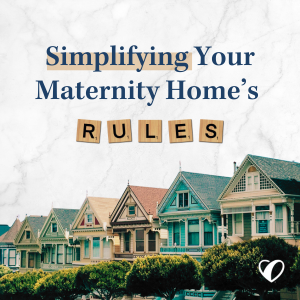Displaying items by tag: simplifying rules
Simplifying Your Maternity Home’s Rules
by Valerie Harkins, Executive Director of the Maternity Housing Coalition
Running a Christian maternity home is a sacred calling—one that requires wisdom, discernment, and an ever-present commitment to the well-being of the women we serve. However, the complexity of house rules and resident handbooks can sometimes hinder rather than help. As leaders, it is essential to periodically review and simplify our guidelines to ensure they align with our mission, support trauma-informed care, and create a healthier environment for both residents and staff.
The Benefits of Fewer, More Impactful Rules
Maternity homes often accumulate an extensive list of rules over time, each intended to address specific behaviors or concerns. While structure is necessary, an overabundance of rules can create confusion, resistance, and an atmosphere of legalism rather than transformation. Research in trauma-informed care suggests that individuals who have experienced significant hardship—such as those in crisis pregnancies—respond better to environments that prioritize clarity, consistency, and emotional safety over rigid control (SAMHSA, 2014).
Here’s why fewer, well-enforced rules lead to better outcomes:
- Increased Adherence – Too many rules can overwhelm residents, leading them to disengage. Trauma-impacted individuals often struggle with authority due to past experiences; simple, clear expectations increase the likelihood of compliance (Bloom, 2010).
- Enhanced Mission Alignment – Every rule should directly reflect your home’s mission. If a rule does not serve a clear and meaningful purpose, it may be more of a hindrance than a help.
- Reduced Staff Burnout – Staff members are tasked with enforcing policies, and an overly complex rulebook increases their workload and stress. Simplified guidelines free them to focus on relationship-building and discipleship rather than constant policing.
- Greater Resident Growth – A structured yet flexible environment allows residents to make meaningful choices, take personal responsibility, and develop life skills that will serve them beyond their time in your home.
Begin reviewing and simplifying your guidelines in four easy steps.
1. Evaluate Your Current Rules
A practical first step is to review each rule through the lens of your mission and impact. Ask:
- Does this rule directly support our core values?
- Is it necessary for safety, order, or spiritual growth?
- Is it enforceable in a fair and consistent way?
- Does it encourage autonomy and personal responsibility?
- Is it communicated clearly and simply?
Rules that do not meet these criteria may need to be revised or eliminated. This review should also include staff and, when appropriate, resident feedback to ensure rules are realistic and effective.
2. Review Your Rules' Biblical Foundation for Clarity and Integrity
Scripture speaks to the importance of simple, truthful, and consistent communication. Jesus instructs in Matthew 5:37, “Let your ‘Yes’ be ‘Yes,’ and your ‘No,’ ‘No.’ For whatever is more than these is from the evil one.” A maternity home should be a place where both residents and staff trust that expectations are clear and that enforcement is fair. If rules are too numerous or inconsistently applied, trust erodes, leading to unnecessary conflict and stress.
Additionally, Colossians 3:21 warns, “Fathers, do not embitter your children, or they will become discouraged.” While maternity home residents are not children, the principle remains: an environment with excessive, unclear, or inconsistently enforced rules can breed discouragement rather than growth.
3. Embrace the Role of Trauma-Informed Care
Trauma-informed care acknowledges that many maternity home residents have experienced significant emotional, physical, or spiritual wounds. A punitive, rigid structure often reinforces their past experiences of instability and rejection. Instead, clear and meaningful rules...
- promote predictability, which is crucial for emotional safety
- encourage respectful dialogue, rather than a power struggle
- allow natural consequences to shape growth instead of unnecessary punitive measures
By embracing a trauma-informed approach, maternity homes create an environment where healing is prioritized over control, ultimately leading to better long-term outcomes for residents.
4. Implement Thoughtful and Clear Communication
Once rules are streamlined, they must be communicated effectively. Consider implementing the following:
- A concise handbook that explains each rule’s purpose
- Regular orientation sessions to reinforce understanding
- A consistent enforcement approach so that residents know what to expect
- Opportunities for open discussion that allow residents to ask questions and seek clarification without fear
___________________________________________________________________________
1. SAMHSA’s Concept of Trauma and Guidance for a Trauma-Informed Approach | SAMHSA Publications and Digital Products. (2014, October). Samhsa.gov. https://library.samhsa.gov/product/samhsas-concept-trauma-and-guidance-trauma-informed-approach/sma14-4884
2. Bloom, S. (2010). Organizational Stress as a Barrier to Trauma-Informed Service Delivery. Springer. https://connectingparadigms.org/wp-content/uploads/2019/05/21360-Organizational_Stress_as_a_Barrier_to_Trauma-Informed-Bloom.pdf

